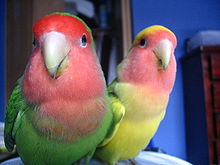| This article includes a list of references, related reading, or external links, but its sources remain unclear because it lacks inline citations. Please help improve this article by introducing more precise citations. (July 2023) (Learn how and when to remove this message) |
You can help expand this article with text translated from the corresponding article in Spanish. (July 2023) Click for important translation instructions.
|




The science of rosy-faced lovebird colour genetics deals with the heredity of colour variation in the feathers of the species known as Agapornis roseicollis, commonly known as the rosy-faced lovebird or peach-faced lovebird.
Rosy-faced lovebirds have the deepest range of mutations available of all the Agapornis species. Generally speaking, these mutations fall into the genetic categories of dominant, co-dominant, recessive, and X-linked recessive (also called "sex-linked recessive"). While this seems fairly straightforward, it can quickly become confusing when a single specimen has multiple examples of these mutational traits.
Base color
All rosy-faced lovebirds, without exception, belong to one of two base colors: Green-series (also referred to as Wild Green), which is a dominant trait, and Blue-series, which is a recessive trait. Within the Blue-series base color, there are currently two recognized variants – Dutch Blue (also known as Aqua) and Whitefaced Blue (also known as Turquoise). These recessive Blue-series traits of Aqua and Turquoise are alleles, and when an Aqua allele and a Turquoise allele are matched in a rosy-faced lovebird, the resulting variant is referred to as a "Seagreen" (also known as "AquaTurquoise"). As the Blue-series alleles are recessive, a bird must receive one of the blue-series alleles from each parent in order for the blue-series trait to be seen visually. A bird that has only one recessive gene for a specific trait is said to be "split" for that trait. Thus, a bird who receives a green base-color gene from one parent and a blue-series gene from the other parent would be visually Wild Green, as Green is dominant, but "split" for the blue trait.
Other mutations
Beyond the base coloring of a rosy-faced lovebird, there are mutations that exist independently of any other mutation. These mutations are of three distinct types: co-dominant (exemplified by the Orangefaced, Dark and Violet mutations), recessive (exemplified by the Edged Dilute mutation), and sex-linked (exemplified by Lutino, Pallid , American Cinnamon, and Opaline mutations).
Co-dominant traits
With co-dominant traits, only one parent bird needs to provide the genetic information that makes up a chromosome pairing in order for the trait to be seen visually (referred to as a Single Factor for that trait) - although a passing of the genetic information from both parents will create a stronger and more easily seen example of the mutation, which is referred to as a "Double Factor" for Dark or Violet, and simply called "Orangefaced" for a double factor Orangefaced bird.
Recessive traits
With recessive traits, the particular mutation can be seen visually only if each parent passes a recessive gene for the particular trait. Thus, while one can visually distinguish a bird with only one co-dominant gene, such as a single factor Orangefaced rosy-faced, a bird with only a single recessive gene, as in the Edged Dilute, will not be seen visually. As with the base-color recessive traits, a bird that has only one recessive gene from one parent's contributed genetic code is said to be "split" for that trait.
Sex-linked traits
Sex-linked traits are a little bit more complex because these recessive traits are carried on the genetic information which determines the gender of a bird. These genes are usually referred to in simplified terms as X and Y genes. In mammals, it is the male that determines the sex of their offspring, in that mammal males have one X gene and one Y gene on a chromosome pairing (XY) and can pass either to an offspring - while a mammal female can only pass an X, due to their chromosomal pairing of XX. However, in birds and reptiles, this pairing is just the opposite: thus, in Lovebirds, it is the female which has an XY pairing and thus determines the sex of an offspring, depending on whether the mother passes an X gene or a Y gene.
It is on the X gene that the genetic information for sex-linked recessive traits is passed. As a sex-linked trait is a recessive trait, each X in a chromosomal pairing must have the recessive trait encoded within it, or the trait will not show visually. However, a female bird only has one X gene, and that gene is paired not with another X, but rather with a Y. Because of this, if a female bird inherits an X from her father that has the sex-linked information attached to it, the female will be visual for the sex-linked recessive trait, because there is no second X to match up with the X passed from the father. This is only true of female birds; since male birds, by genetic definition, must have two X genes (XX), both X genes must have the same sex-linked recessive information in order to show that sex-linked recessive trait visually.
References
External links
| Tribus: Psittaculini | |
|---|---|
| Genus | (extinctions: † indicates a species confirmed to be extinct, ₴ indicates evidence only from sub-fossils) |
| Psittinus | |
| Psittacella | |
| Geoffroyus |
|
| Prioniturus | |
| Tanygnathus | |
| Eclectus | |
| Psittacula |
|
| incertae sedis (probably Psittaculini) |
|